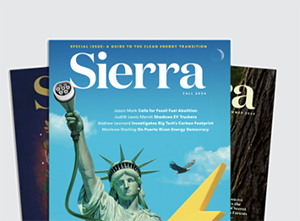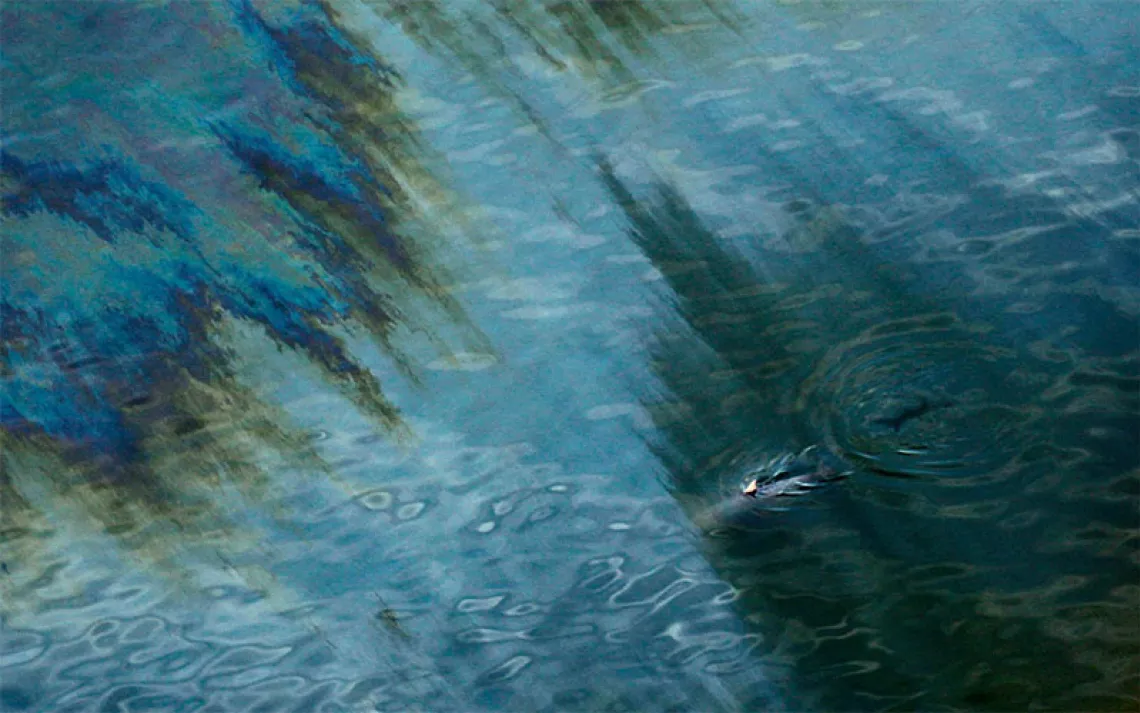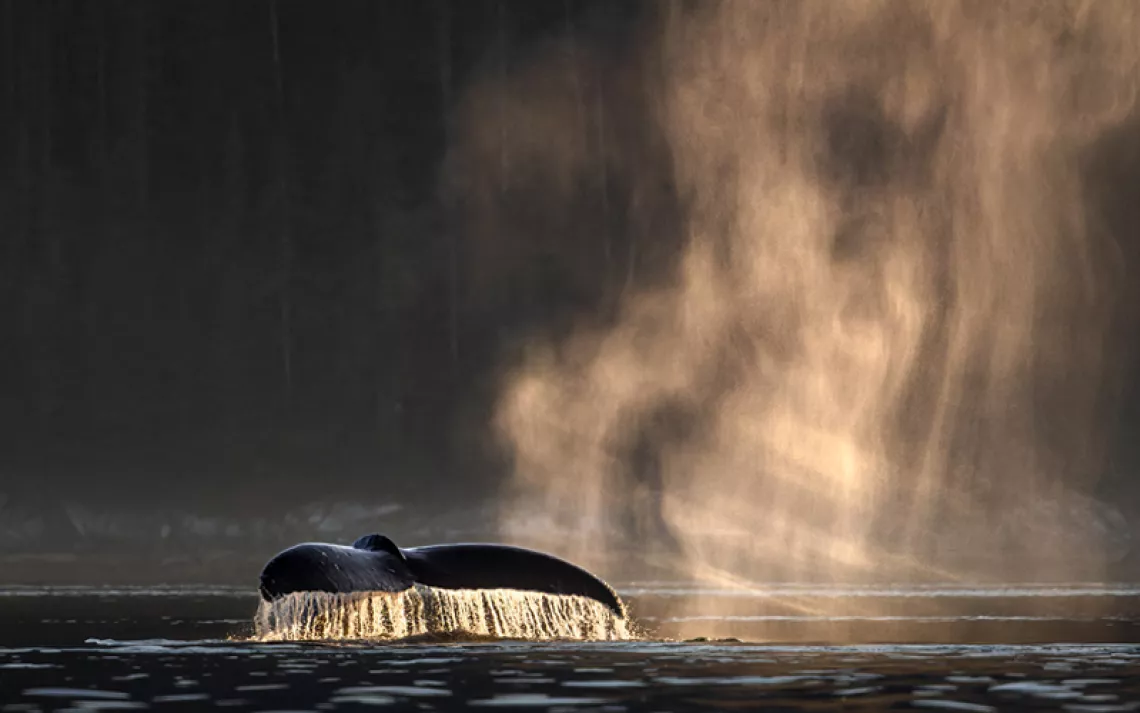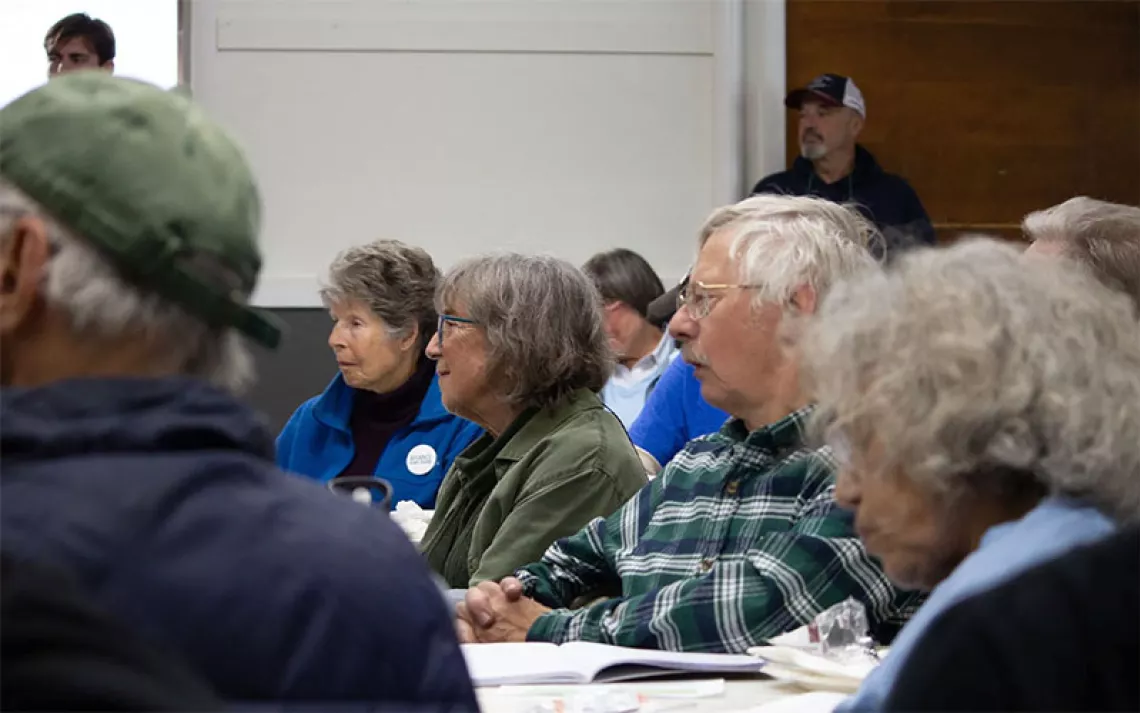Fabien Cousteau
Ocean explorer and Plant a Fish founder

Courtesy of Marc Evan
Fabien Cousteau—third generation ocean explorer, swashbuckling underwater filmmaker, and Renaissance environmental man—had a brainstorm late one night while reading an article about a tree-planting project. "Why does restoration stop at the water line?" he wondered. "Why aren't we planting fish?" He launched the nonprofit Plant a Fish in June to commemorate his grandfather Jacques-Yves Cousteau's 100th birthday and World Oceans Day—just as oil from the BP disaster was gushing into the Gulf.
Plant a Fish's first project was replanting oysters in the Hudson River with students from the Urban Assembly New York Harbor School. Next up: planting mangroves with high schoolers in Florida, restoring hawksbill populations with torgugueros (turtle egg hunters) in El Salvador, and cultivating corals with elementary schools and community groups in the Maldives and Florida Keys.
Sierra: How long has Plant a Fish been in the making?
Fabien Cousteau: It's been in the making my whole life. That said, there's been an increasing need and desire in me to create something that would start restoring our oceans around the world. Thanks to my grandfather, I've been diving since my fourth birthday, and I've been on this planet long enough that I've seen a drastic change in the undersea world and its environment. And it's very frustrating, because I grew up with a very beautiful undersea world and, as we're starting to see now, things have changed a lot, and not for the better.
Sierra: It seems appropriate that you'd be involved with the New York Harbor School for the oyster project. Was your life outside the classroom like an international ocean school?
Cousteau: Absolutely. It's funny how so many people think of the world as countries—these political lines on a map. Nature doesn't care about these invisible lines on a piece of paper. Everything that goes on in nature affects everybody regardless of where you live, whether it's in the atmosphere, on land, or in the water. Fish don't have passports.
Sierra: We don't realize we're in a closed system.
Cousteau: It's our one and only life-support system, and it's absolutely a closed system. Everything ends up in the ocean. Everything that happens on land, from the top of the tallest mountain on down, eventually gets into the ocean. It's our basin. All that stuff you're dumping down your drain and all the garbage in the streets washes down and accumulates in the ocean. It doesn't have anywhere to go from there, so it starts festering and poisoning our oceans. Which is not the end of the line, because once that starts happening, and it is, all the food that depends on the oceans—which is about 70 percent of our diet, either directly or indirectly—is coming back to our plates. So it's being poisoned by our actions; it's being depleted. Traditionally, humans have though of the ocean as an endless resource and a garbage can. I think consciousness is now starting to turn around a little bit—not fast enough for my tastes, but we can change that. And we have to. We don't have a choice. There is no Planet B. We can't trash this place and go somewhere else.
Sierra: Speaking of the fish landing on our plates, you have a famous chef involved in Plant a Fish: Eric Ripert.
Cousteau: Some may think at first glance that's an odd thing to do. But one of the most important things is curtailing and changing our bad habits. I am looking to have friends in the cooking industry—chefs, restaurateurs, and such—who depend on, among other things, a healthy ocean to be able to provide a service. Their careers are based around the mastery and artistry of cooking, and they don't necessarily have the time to do the research or the right people to guide them to make the right choices. It's not that people don't want to make the right choices, but when going through cooking school, you don't necessarily have those kinds of classes.
At the executive chef level, they're managers of a huge enterprise, and those guys barely sleep. Eric Ripert has Le Bernadin, a phenomenal Michelin-rated restaurant, and another restaurant down in the Caymans [Blue] and one in D.C. [Westend Bistro]. All these things make it so that he has very little time to do any research, but he is very much about protecting the oceans in his philosophy. He wants to work together to make his industry more sustainable and is very supportive of my efforts to restore our water bodies and to get people connected to them.
Now is the time for environmental journalism.
Sign up for your Sierra magazine subscription.

If we want to keep eating beautiful foods, we have to make sure that our oceans are healthy on both a pollution level and a sustainability level. We have to stop acting as hunter-gatherers in the ocean, which we did 10,000 years ago on land, and we have to start looking at this planet as farmers—and the oceans are no exception. We have eaten away almost 60 percent of the total fish stocks on the planet since the 1950s. We have lost over 90 percent of pelagic fish—the tunas, the billfish, the sharks, all the big traveling fish—since the 1960s. The alarm bell rang 20 years ago, but no one listened.
Look at the bluefin tuna, which is now getting a lot of press. The Atlantic bluefin is down to 3 percent of the original numbers and on the verge of going extinct within the next few years if we don't do something today. We have to start looking at the oceans and those resources as a bank account: Stop eating away the capital and start living off the interest. We're at the point now where we need to start paying back some of that capital.
Sierra: I read that the oysters the high schoolers planted with Plant a Fish won't be safe to eat within their lifetime. Is that true?
Cousteau: Yes and no. It's really dependent on how we address the problem on land. The cleaner the water that the oysters grow in, the cleaner the oysters. The cleaner the oysters, the more likely we are to be able to eat them. Oysters grow to a reproductive size in a year and a half, so they're fairly quick-growing, and one adult Northeastern oyster lives about 12 years under ideal circumstances. So during its lifetime, it accumulates a lot of things. A Northeastern oyster filters up 50 gallons of water per day—it's a wonderful catalytic converter of the ocean, so to speak. Well, just like I wouldn't suck on a tailpipe, I wouldn't necessarily eat oysters in an area that has waters that aren't anything but absolutely purely clean.
Now, that said, they can do a number of things for us by restoring their population. Number one, and probably the most important, is that oysters build reefs. They're akin in the temperate waters of the Hudson River, for example, to coral reefs in tropical waters. A lot of species depend on them for food, shelter, and so forth—over 200 in just the Hudson River area itself. And the sooner stuff stops flowing—nasty stuff like PCBs, PPDDs, dioxins, and such that leech from land into the water system—the sooner the oysters are clean themselves and the sooner we can look at them as a food source. But only if—and this is a big "if"—we use them in a manner that is living off the interest.
Sierra: Other Plant a Fish projects you've planned are replanting sea turtles in El Salvador, replanting corals in the Maldives and the Florida Keys, and replanting mangroves. I'm curious how you selected these sites and how you find local schools and community groups to partner with.
Cousteau: These are all long-term projects—not a one-time-only thing. I'm not a short-time-thinking person. This is an inheritance for the future, and what better way to get people interested and understanding that than getting them involved. The key elements are education, empowerment, and restoration. Education: getting people to connect with the ocean, to understand why it's important, why they should care, whether they're on the oceanside or not. Empowerment: saying, you can make a difference, and come with us, let's go do it together. And of course the restoration aspect is the payoff.
So mangroves is a fairly straightforward one. We've lost over 40 percent of the total mangrove numbers in the Caribbean in general, and more than that in Florida. I don't have the exact numbers, but I would anticipate somewhere around 60 to 65 percent of mangroves have been lost in Florida through development, et cetera. And we need to restore some of those mangroves, as well as some of the coral reefs, which are in great peril right now. Depending on where you're talking about in the Caribbean, over 70 percent of the corals are either dead, dying, or in bad health—70 percent. And that's since 1979. That's crazy.
I remember diving in the Florida Keys when I was 12 and finding it to be an absolute paradise. I went back a few years ago, and it's a desert wasteland compared with what it once was. You can still find corals, and you can still find a few healthy areas of corals, but nothing like I saw when I was a kid. Oysters was an easy one, because I'm based out of New York City and I felt it was absolutely imperative that I give back to my own backyard. And that's part of the philosophy of Plant a Fish: getting connected with your own aquatic backyard, so to speak, and giving back to your community. The oyster program will eventually expand from here to other places like the Chesapeake and Boston. We probably will see a time, if we keep going the right direction, where we can actually eat wild Hudson River oysters. But we have to keep tracking in the right direction. So maybe 20 years from now, I'll be happy to announce—
Sierra: The opening of Fabien's Oyster Shack?
Cousteau: Well, I personally would be a very bad person to open up an oyster shack, since I don't eat bivalves. There needs to be the sentiment of "Eat an oyster, plant an oyster." That's what we're talking about with Eric [Ripert] and so on. It's a very healthy way to think about our world: If you take something, give something back. And this is nothing new. That's exactly what the Indians of North America used to do, for example: They took only what they needed, and they would replace it with something else. So why not? If you want to enjoy an oyster, great. If you're going to buy a dozen oysters, why not spend a little extra to ensure that you can buy a dozen oysters next year. Planting oysters is not expensive, because nature lets them grow, so you're just ensuring that you can enjoy this, and your children and grandchildren can enjoy this.
Sierra: Tell me about Plant a Fish's turtle restoration project.
Cousteau: I'm working with a community in El Salvador to restore the most endangered sea turtle population in the world: the Eastern Pacific hawksbill turtle. Hawksbill turtles have been harvested for centuries because of their absolutely beautiful shell. Now that's banned, but people in many communities around the world are still eating turtle meat or turtle eggs. In El Salvador it was just ruled last year that turtle-egg hunting was illegal, but it's very lightly enforced. So tortugueros, who hunt for turtle eggs, dig up the turtle nests and sell the eggs for 25 cents on the street, even though it's illegal. The Plant a Fish project uses their talent for finding turtle nests, and instead of having them be turtle-egg sellers, we now have them as being turtle conservationists. They go and find these turtle nests, and in cases where the turtle nests might be in danger of any sort, we transport them to a nursery, where it's fenced and guarded, and we wait till the turtles hatch—so they're not being eaten by predators or human beings, or trampled on by an SUV or whatever. So we have a much lower mortality rate. The turtles have a leg up there, and once they hatch, and we know they're healthy, we release them into the wild. We'll see in five or six years—when they come back to nest and we do our turtle counts—if we've made an impact.
The entire community is involved. It stimulates ecotourism and the economy, and so it's good for everybody. The tortugueros make a better living and a more sustainable living this way. I've yet to see a tortuguero who doesn't want to do this. They understand. It's not that they want to go and decimate the turtle population; that's the only way they can make a living—they make $125 a month. We can easily have them provide a better living for their families while at the same time protecting and restoring this sea turtle population.
Sierra: You launched Plant a Fish about six weeks after the BP oil spill. What were your first thoughts on hearing that the oil was gushing freely?
Cousteau: I was devastated. This is neither the first nor the last oil spill—until we get off our hundred-year-addiction to oil, we'll see more oil spills. But this particular one was—well, I don't want to say was, because we're still dealing with it, and we're going to be dealing with it for another 20 years; the cleanup is still long-term—but it was one of those things where I was getting so excited to launch Plant a Fish, and here we are, a half a month away, and I'm going to do it as a commemoration to my grandfather on his hundredth birthday. And all of a sudden this disaster happened. It hurts to see this because it's a huge setback for the oceans; it's a huge setback in terms of the health of our planet. The only reason we're all paying attention to this is because it's so close to shore and we're seeing the devastation firsthand. And most of it's been masked, I hate to say. But we're just now starting to understand what happens and what the impacts and implications are of such a disaster. I don't think we'll fully figure those out at least for another 5 to 10 years.
I think it was a wakeup call that the planet needs us more than ever. I think the BP oil spill is a complete disaster for many species. The bluefin tuna spawn in the Gulf, and the timing couldn't have been worse, because the bluefin were spawning at the time of the oil spill. Five species of turtle live in the Gulf, some of which were nesting at that time. The Kemp's ridley lives only in the Gulf of Mexico, and it's one of the most endangered sea turtles as a whole—perhaps even the most endangered sea turtles as a whole, not as a population. So it's devastating to that particular turtle, as well as to the larger animals: all the air-breathers who come up in the middle of this oil spill, all the plankton-eaters who filter-feed through it. They don't have a sense of taste the way we do when they filter out the plankton, so it's not like they taste the oil. They sense the oil, but compared with us, it's not like they're used to dealing with oil spills. You've got whale sharks and sperm whales and the largest of creatures being affected and dying, so you can only imagine [what's happening with] the small stuff. The base of the food chain, the basis for life in the ocean, is the plankton, which are all dying off and suffocating.
You have to remember that oil is not just a cancer-causing toxic chemical; it's also a suffocant. It coats something, like gills, and the animals can't breathe anymore and suffocate to death. If they don't suffocate to death, then they get poisoned. And for the lucky ones that get limited exposure, they get to live a little bit longer, and eventually they end up on our plate, and then we eat the stuff.
Sierra: I saw a video clip in which you said the water in the Gulf was akin to a "vinaigrette."
Cousteau: I compared it to a vinaigrette because everyone thinks, "Why can't we contain this oil spill with booms?" If [the ocean] were a bathtub, oil would have the tendency to float, and we could skim it off. But it's not a bathtub. It's a dynamic system, with storms, wave activity, currents that churn the oil down deep and up above. It's like opening Pandora's box. So, yeah, it is like shaking up a vinaigrette. And that's maybe more of the way we should look at this.
Sierra: And you're working to restore sea turtles in the Gulf.
Cousteau: I've been part of some transfers of sea turtles that have been rescued, and we're looking at sea turtle restoration programs. I want to be very clear that although we're planning on stepping up our programs, we—as Plant a Fish and as a human species—have got to step up our restoration efforts because of the Gulf oil spill. It's going to be a while before we can start doing restoration. We first have to clean. Once things are clean enough, then we can start with restoration. But we've got to plan the restoration efforts now. We don't want to get caught with our pants down, like BP did with this oil spill. As soon as we hear from the scientists who say, "OK, this area is clean enough and we need to restore it," that's when we go in and get communities to participate in mangrove restoration, sea grass restoration, oyster restoration, turtle restoration, and all those things. Then we go in full bore.
If we give nature a break, it will heal itself. But it needs a long break, and we need to give it a boost. It's a akin to bringing it to the ICU and giving it intensive care. We need to give it an IV, and it has to be calculated, local, no-impact—or positive-impact, if anything. It needs to have a personal touch, and that's why we need to have a grassroots movement with local communities. That's the whole reason Plant a Fish exists: to engage local communities in these actions.
Sierra: How can people get involved in the Gulf restoration effort and the Plant a Fish projects?
Cousteau: The easiest way for someone to get involved is via donations, because the money goes directly into the program for restoration. So if people can't be directly involved in a restoration effort, at least they can have someone do it on their behalf. As far as other things people can do, if nothing else, we all need to curtail our bad habits. And there are easy ways to do that right from our own home.
In the case of going to a restaurant or supermarket, take a seafood-watch card with you [e.g., one from the Blue Ocean Institute or the Monterey Bay Aquarium]. You can download it onto your mobile device or you can get a physical card to bring with you, so you can read what's a good choice, what's a bad choice, and make a much better informed decision. If you see something on the menu that's on the bad list, give that card to manager or maître d', so that you can pass along that information. As a consumer, as the end of the line, so to speak, you have the ultimate decision-making power. Say, "I would love to come here and recommend to my friends to come here if you have more sustainable options."
You can also start a Plant a Fish initiative in your community. It's a matter of two things: funding and planning, and the funding will come if you have a good plan. If there's something that a person or a community wants to start, drop us a line and we'll work together on getting that up and running, if it's something that is viable and makes sense—we're not going to plant tuna in Lake Michigan.
Sierra: Is there anything else you would like Sierra Club members to know?
Cousteau: Water connects everything. That's the basis for everything I do. It's a simple notion that we tend to forget. If we can keep that in mind in our everyday deliberations and make appropriate choices by taking into account the impact on the next generations, we will make a big difference in the way we see the world and the way we do things and will live more sustainably with the planet. My grandfather used to say, and this is what I grew up with, "People protect what they love." And how can people protect what they don't understand? So it behooves everybody to go out there and get connected, to understand the world, that it's a closed system, and water connects everything.
 The Magazine of The Sierra Club
The Magazine of The Sierra Club



